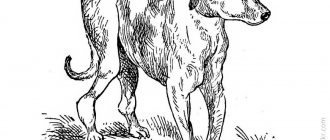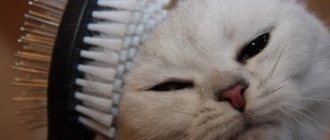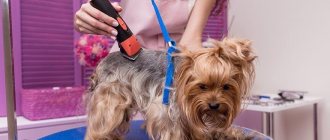“Whoever says you can’t buy happiness has never bought a puppy.” Wilfred P. Lampton
Often, when looking for a new pet in the form of a purebred puppy, when looking at advertisements, websites or various forums, future owners come across loud headlines like “Two show-class husky girls are looking for a home!” or “Premium Golden Retriever puppies available for reservation.” A person inexperienced in the field of breeding and keeping dogs will immediately be confused by the terms “ show ” and “ premium ” class. If you are interested in this topic, and you are interested in finding out what “classes” in general are in the world of purebred dogs and what they are like, then this article will definitely help you understand everything.
What is it: pet, breeding and show class for a puppy?
Making a choice between strange terms is not that difficult. To do this, you need to understand their meaning and decide on the purpose of acquiring a new pet.
Decoding concepts
Class division plays a big role in breeding. The more a puppy meets the standard, the more it is valued. The cost of such animals is always higher, since with a high probability their mating will produce an equally high-quality and expensive litter.
The offspring of purebred four-legged animals are divided into 3 groups:
- show (from the English show - exhibition, display);
- breed (from the English breed - offspring, breed);
- pet (from the English pet - pet).
In official documents, puppies and dogs do not indicate that this is a pet class, breeding or show. Instead of these marks, less valuable animals are given the word “plembrak”, which indicates non-compliance with the breed standard.
Classification criteria
The breeder divides the born puppies into quality classes in order to understand who to work with next, who to sell at a higher price, and who needs sterilization. The final grade is based on the following criteria:
- proximity to the standard (the more matches, the more expensive the animal);
- character atypical for the breed (cowardice, aggression, lack of working instincts);
- the presence of slight deviations in appearance allowed by the standard (blue eyes in a corgi and bright red markings on the coat of an East European shepherd);
- the presence of serious abnormalities (the tail raised above the back of an Italian greyhound) and diseases (dysplasia, cryptorchidism) that are considered disqualifying characteristics.
The quality of a puppy is determined after 2 months, but as it grows, it may change. An accurate assessment can only be made closer to a year, so breeders recommend buying animals for breeding at least after 4-6 months.
How to choose a pug puppy. Male or female
First of all, make a decision regarding the gender of the dog. Both male and female pugs are distinguished by their devotion to their owners, but some nuances must be taken into account. The bitch goes into heat twice a year, which lasts about 3 weeks. Even if the animal is very clean, stains will remain on the floor and bedding during this period
In addition, the dog will begin to pay attention to the opposite sex, so you will have to carefully monitor so that unwanted mating does not occur
If the time period during which the bitch shows interest in potential partners is limited, then the male is invariably concerned about this issue. Overly temperamental representatives of the breed mark the territory of the house, as a result of which the corners in the apartment and furniture suffer. But the shedding of a male dog is not as intense as that of a female dog. By nature, females are calmer, while males are more active. Decide for yourself who you like best. In any case, a small pet will bring a lot of joy.
How to choose a pug puppy
Show class for dogs: pros, cons, who is suitable for them
Show puppies are characterized by ideal compliance with the standard. Such babies are born very rarely, which explains their impressive cost. They are obtained either from the same parents, or from four-legged breeding class.
Breeders do not always offer elite animals for sale. They often keep them for themselves to produce new high-quality offspring. Such pets can be sold even more expensive due to their good pedigree.
The advantages of show class include:
- maximum compliance with the standard;
- presentable appearance;
- the possibility of creating a profitable breeding business (high probability of giving birth to high-quality puppies);
- advantage over other competitors in dog shows (show pets often take prizes).
The main disadvantage is the high price. Not every owner can buy an elite animal. This class also has several other disadvantages:
- long waits and serious checks (the queue at prestigious nurseries is scheduled several years in advance, and future owners are asked for recommendations);
- possible problems with the nervous system (found in dogs from breeders who focus exclusively on ideal conformation);
- frequent congenital pathologies (arise due to inbreeding).
Show puppies are suitable for owners planning to engage in further breeding or a show career. Please note that in the latter case, getting the champion title is not so easy. In addition to appearance, you will need to monitor the quality and regularity of training.
What categories are animals divided into at exhibitions?
The largest dog show is WDS, or World Dog Show. It holds competitions once a year in one of the member countries of the FCI, or Federation Cynologique Internationale. In Russia it is represented by the RKF, that is, the Russian Cynological Federation.
At shows, puppies are divided into classes not by quality, but by age. Previously acquired titles are also taken into account. Before the actual performance, the four-legged participant is registered and falls into 1 of 8 classes:
- baby (baby) - 3-6 months (pets are brought here solely for the sake of experience and familiarity with the atmosphere at the exhibition);
- puppy (puppy) - 6-9 months;
- junior (junior) - 9-18 months;
- interte (intermediate) - 15-24 months (suitable for young animals with the correct physique, which cannot yet be classified as adults)
- open (open) - from 15 months to 8 years (the most numerous class with high competition, suitable for dogs that have won interte several times in a row);
- working (worker) - over 15 months with a working diploma;
- champion (champion) - over 15 months with a champion title;
- veteran (veteran) - over 8 years old.
Competitions are held both at the national and international levels. Receiving a championship certificate under the international system is more prestigious, as it is equivalent to two whole national certificates. To participate, a pedigree recognized by the RKF is required.
Conclusion
If you decide to take a pet for your soul, but want it to be purebred, then feel free to take the most inexpensive option. In the pedigree of dogs it is not noted that this is a pet class, since such a division is not usually reflected in official documentation. Only you will know about the quality of the four-legged exterior. A less prestigious status will not diminish his devotion and love towards his owners, so waiting for years for a more elite animal simply does not make sense.
Breeding class for dogs: pros, cons, who is suitable for them
Breeding puppies make up the majority of the litter. Despite minor flaws, they still fit into the breed standard. They are allowed both for breeding and for exhibitions. Thanks to competent training, such pets often outperform more elite show representatives.
The advantages of the breed class include:
- lower prices compared to the show;
- high probability of having a luxurious litter when mating with an elite partner.
Among the disadvantages are a greater number of anatomical defects compared to the show class and various genetic pathologies. Not a single high-quality four-legged animal is immune from the latter, since the main reason for their appearance is selection, which puts quality first.
Breed-class animals are suitable for exhibitions and breeding. Due to the high cost of show pets, most breeders use only one such sire for mating, and choose a breed-class dog as the second. In the latter case, females are most valued, so they are always more expensive than males.
Pugs history
Back in the days of the Chinese Celestial Empire, these sneaks were assigned a special role. These cute fatties were constant companions and companions of high-ranking gentlemen. But one should not mistakenly assume that the function of the dogs was purely decorative. On the contrary, such closeness to the rulers of the Great Empire and the European bourgeoisie emphasizes the fact that in addition to a beautiful face, the dog is also a very good friend, companion and helper.
In ancient times, dogs lived in rich palaces, and their wrinkles on their faces, due to their resemblance to hieroglyphs, were a special imperial sign.
In Europe, ladies from high society called pugs “boudoir dogs” and carried them with them everywhere. The forefathers of the modern pug were somewhat different, they were taller, and there were even fewer folds on the face and body
Pet class for dogs: pros, cons, who is suitable for them
After analyzing the basic concepts, it is easy to guess that pet-class dogs are puppies that have at least some disqualifying characteristics. Unlike mestizos, they are still considered thoroughbreds, and the defects they have do not affect their health and quality of life.
The main advantage of the pet class is its low price. The cost of such animals is the most favorable, but there are also disadvantages:
- a strict ban on participation in exhibitions and breeding (such pets must be sterilized or neutered to eliminate the risk of deterioration of the genotype in future generations);
- high probability of deception when purchasing (an ordinary person is unlikely to distinguish a mestizo from a purebred dog with flaws).
Pet-class animals are suitable for owners who are looking for a reliable four-legged friend. Despite the impossibility of becoming producers or participants in a dog show, such pets have no problem engaging in canine sports, hunting, and even rescuing people.
Origin story
It is still not known for certain where dwarf pugs came from. The only thing that is clear is that representatives of this breed, according to current canine rules, are considered a waste. That is why the dogs never received official recognition.
Mini Toy Terrier (dwarf): description of the breed
As for ordinary pugs, their homeland is China. The first mentions of them date back to the 5th century.
Note! Mini Pugs should not be confused with American Elk Pugs, since the latter were bred in the USA by crossing with Pekingese and subsequently received official recognition. American pug lo shi
American pug lo shi
Titles awarded by RKF
CHAMPION OF RUSSIA JUNIOR CHAMPION OF RUSSIA (YUCHR) VETERAN CHAMPION OF RUSSIA (UChR) CHAMPION OF RKF (CHRKF) YOUNG CHAMPION OF RKF (YUCHRKF) VETERAN CHAMPION OF RKF (UChRKF) Champion of the National Club - or ChNKP (Ch.Club) Junior Champion of the National Club - or JChNKP (JCh.Club) CHAMPION-MAINER (CHPR) CHAMPION OF BREED (CHP) JUNIOR CHAMPION OF BREED (JCHP) VETERAN-CHAMPION OF BREED (VChP) GRAND CHAMPION OF RUSSIA (GHR) VETERAN-CHAMPION OF BREED (VChP) YOUNG GRAND CHAMPION OF RUSSIA ( YUGChR) VETERAN GRAND CHAMPION OF RUSSIA (VGCHR) ABSOLUTE CHAMPION OF RUSSIA (AChR) WINNER OF “EURASIAN” YOUNG WINNER OF “EURASIAN” VETERAN WINNER OF “EURASIAN” WINNER OF “RUSSIA” YOUNG WINNER OF “RUSSIA” VETERAN WINNER OF “RUSSIA”
Additional ideas
- The animal should not be wrapped in a blanket. You can try to do it without using force. You can put it on the table and turn it away from you. The main thing is not to show the cat the medicine in advance.
- Before giving your cat deworming medicine, you need to prepare everything first. The tablet must be removed from the blister and, if necessary, crushed. When administering the drug, every second will count.
- In order to properly open your pet's mouth, you need to insert your finger between the front teeth. Then firmly but painlessly press on the lower jaw.
- To make the cat more flexible, you can hold it by the withers.
- Never let your cat go until she licks her lips. If she licks her lips, then this is a sign that she has swallowed the medicine.
- Deworming tablets, which have an extremely unpleasant odor and taste, can be kept in the refrigerator before use. Cold can reduce odor and eliminate bitterness at least for the duration of taking the product.
Less hassle with teenagers
At what age to choose a pug also depends on your desire. If you prefer a small puppy, it is better that he is already two months old. Then he will be more independent. By this age, the breeder will have already taught him to eat from a bowl and, perhaps, even go to the toilet in a diaper.
If you want to take an already grown puppy (3-8 months), then you can get a dog with a full set of vaccinations and already trained to use the toilet outside. But there is also a risk of getting an animal with developed character flaws.
A pug under the age of one year gets used to its new owner quite easily. Usually this period does not take much time. Within a week, the teenager will feel completely free.
By choosing a mature puppy, you will more clearly see the color, condition of the teeth, fur, bones, ear set and tail. When assessing posture, take a special look at the dog when it is standing. It is in the rack that all the advantages of the case are clearly visible. It should be square, that is, the height at the withers should be equal to the length of the body.
Classes in accordance with the WCF, CACIB, CAC system
There are clubs and organizations around the world that evaluate the intellectual and physical characteristics of animals at exhibitions. Pets are awarded ranks and titles depending on many factors.
For example, the WCF (World Cat Federation) organizes cat shows and shows that must meet certain criteria. Judges assign classes and titles to cats, and organizers issue licenses.
The largest dog show is WDS. Countries that are members of the FCI (Federation Cynologique Internationale) participate in it. In Russia it is RKF. Before the exhibition, the dog is registered in a certain class depending on its age, there are 8 of them: puppy quality classes from “baby” to “veteran”. Next, the title is awarded: “best” for young dogs, and CACIB, CAC, BOB and others for adults.
Note! A pet can receive the title of not only National Champion, but also World Champion if it meets all established standards and shows its best side.
There are 3 classes of dogs in total, which are not indicated in the documents, but are generally accepted. This is a show, a breed and a pet. A show is an ideal dog in all respects, a breed is a pet with a small flaw, and a pet class in dogs is an ordinary pet. Before purchasing, the future pet owner must understand what he wants from the dog. If the owner’s goal is exhibitions, then he must be prepared for a lot of work on the pet and high costs. But if a person just wants to make a friend, then it is better to choose him from the pet group.
Source











